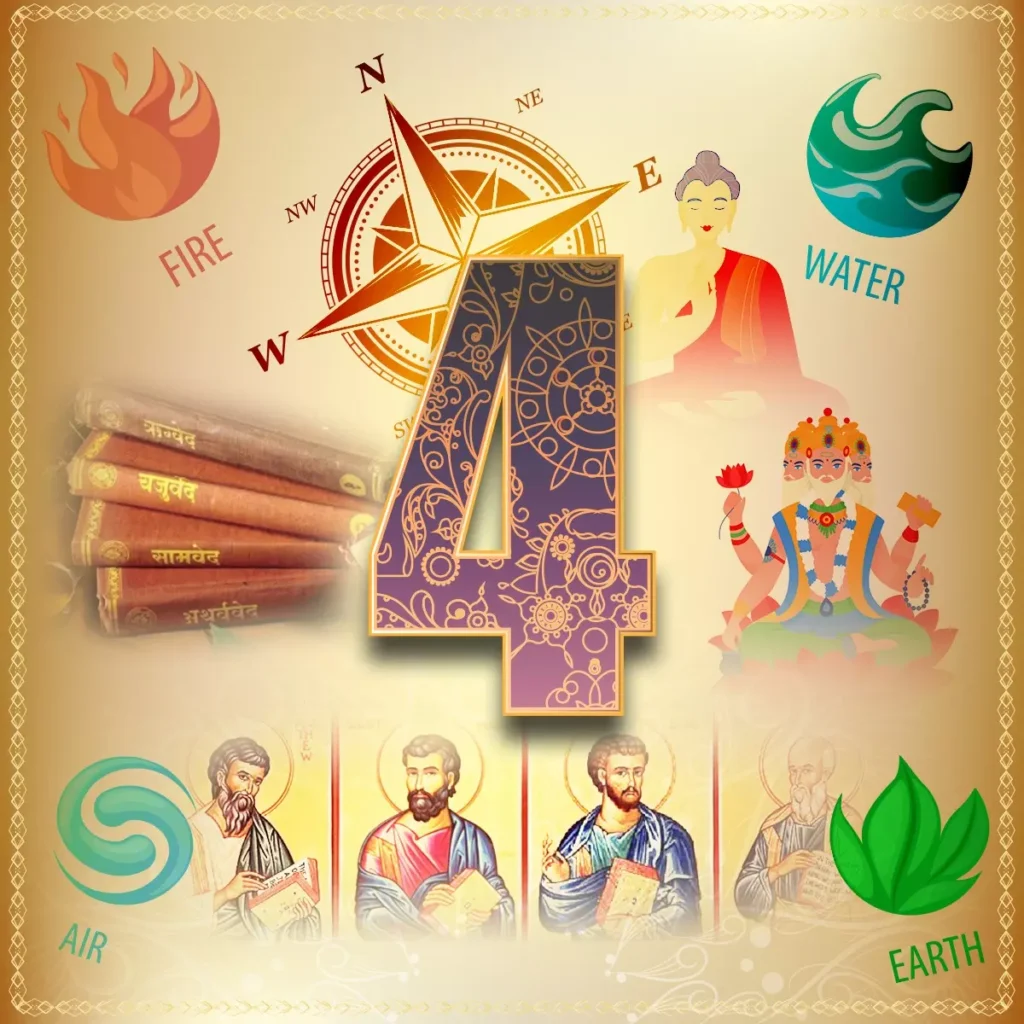The number four holds significant symbolism and significance in many religions and belief systems around the world. The number four is often seen as representing completeness, balance, or cosmic elements such as the cardinal directions or the elements of earth, air, fire, and water. The concept of the “four ages of man” is a recurring theme found in various mythologies, religions, and philosophical systems throughout human history. It generally refers to a cyclical or sequential division of human existence into distinct stages or ages, often associated with different characteristics or qualities. Here are some examples:
“Twelve thousand divine years constitute a period of the four Ages, and a thousand of the four Ages is called a day of Brahman, or an aeon (kalpa), in which there are fourteen Manus. At the end of the aeon there occurs the occasional dissolution brought about by Brahman.”
– Vishnu Purana, Hindu text
“There are, O monks, these four lights. What four? The light of the moon, the light of the sun, the light of fire, and the light of wisdom. Of these four lights, the light of wisdom is supreme.”
– The Buddha
“For instance, there is the well-known tetrapharmakos, or four-fold healing formula: ‘God presents no fears, death no worries. And while good is readily attainable, evil is readily endurable.’ The abundance of collections of Epicurean aphorisms is a response to the demands of the spiritual exercise of meditation.”
– Pierre Hadot, philosopher and historian
Hinduism:
In Hinduism, the number four is associated with many concepts. It represents the four Vedas, or sacred texts (Rigveda, Yajurveda, Samaveda, and Atharvaveda), the four varnas or social classes (Brahmins, Kshatriyas, Vaishyas, and Shudras), the four stages of life (Brahmacharya, Grihastha, Vanaprastha, and Sannyasa), and the four aims of human life (Dharma, Artha, Kama, and Moksha). Additionally, the Hindu god Brahma, who is considered the creator of the universe, has four faces representing the four directions. In Hinduism, the “four ages of man” are known as the “Yugas” and are believed to be part of a larger cosmic cycle of time called the “Mahayuga” or “Chaturyuga.”
Buddhism:
In Buddhism, the number four is associated with the Four Noble Truths, which are considered the foundational teachings of Buddhism. The Four Noble Truths are: the truth of suffering (Dukkha), the truth of the cause of suffering (Samudaya), the truth of the cessation of suffering (Nirodha), and the truth of the path to the cessation of suffering (Magga). The number four is also associated with the Four Immeasurables (Brahma-vihara), which are virtues or qualities to cultivate in order to attain enlightenment: loving-kindness (Metta), compassion (Karuna), sympathetic joy (Mudita), and equanimity (Upekkha). In some Buddhist traditions, the “four ages of man” are known as the “Four Ages of Decline” or the “Four Ages of the Dharma.” These ages are associated with the deterioration of Buddhist teachings and practice over time, with each age believed to be shorter and marked by declining moral and spiritual qualities.

Christianity:
In Christianity, the number four is often associated with the four Gospel writers: Matthew, Mark, Luke, and John, who wrote the four canonical Gospels in the New Testament of the Bible. These four Gospels are considered to be the primary sources of Jesus’ life, teachings, and ministry, and are central to Christian faith and doctrine.
Native American Religions:
In many Native American religions, the number four is associated with the four cardinal directions (north, south, east, and west) and the four elements (earth, air, fire, and water), which are believed to represent the fundamental aspects of creation and the natural world. The number four is often used in rituals, ceremonies, and symbolism related to the balance and harmony of nature.
Islam:
In Islam, the number four is associated with the Four Caliphs, who were the immediate successors of Prophet Muhammad and considered the rightful leaders of the Muslim community. The Four Caliphs are Abu Bakr, Umar, Uthman, and Ali, and they hold a special significance in Sunni and Shia Islam as key figures in shaping Islamic history and leadership.
Chinese Religions:
In Chinese religions, such as Taoism and Confucianism, the number four is associated with the Four Symbols, also known as the Four Guardians of the Four Directions. These symbols, which include the Azure Dragon of the East, the Vermilion Bird of the South, the White Tiger of the West, and the Black Tortoise of the North, are considered protective deities associated with celestial or terrestrial powers. In Chinese philosophy, the “four ages of man” are known as the “Four Seas” or the “Four Ages.” These ages are associated with the changing patterns of human civilization and are described as the Age of Happiness, the Age of Comfort, the Age of Want, and the Age of Disorder. Each age is believed to have its own unique social, moral, and cultural characteristics.
Greek mythology:
In Greek mythology, the concept of the “four ages of man” appears in the works of Hesiod, a Greek poet. The ages are referred to as the Golden Age, Silver Age, Bronze Age, and Iron Age. The Golden Age is described as a time of peace, abundance, and harmony, while the subsequent ages are characterized by increasing moral decay and suffering.
Norse mythology:
In Norse mythology, the concept of the “four ages of man” is mentioned in the Poetic Edda, a collection of Old Norse poems. The ages are referred to as the Golden Age, the Age of Grain, the Age of Ashes, and the Age of Iron. Each age is associated with different characteristics and events, including the creation and eventual destruction of the world.


